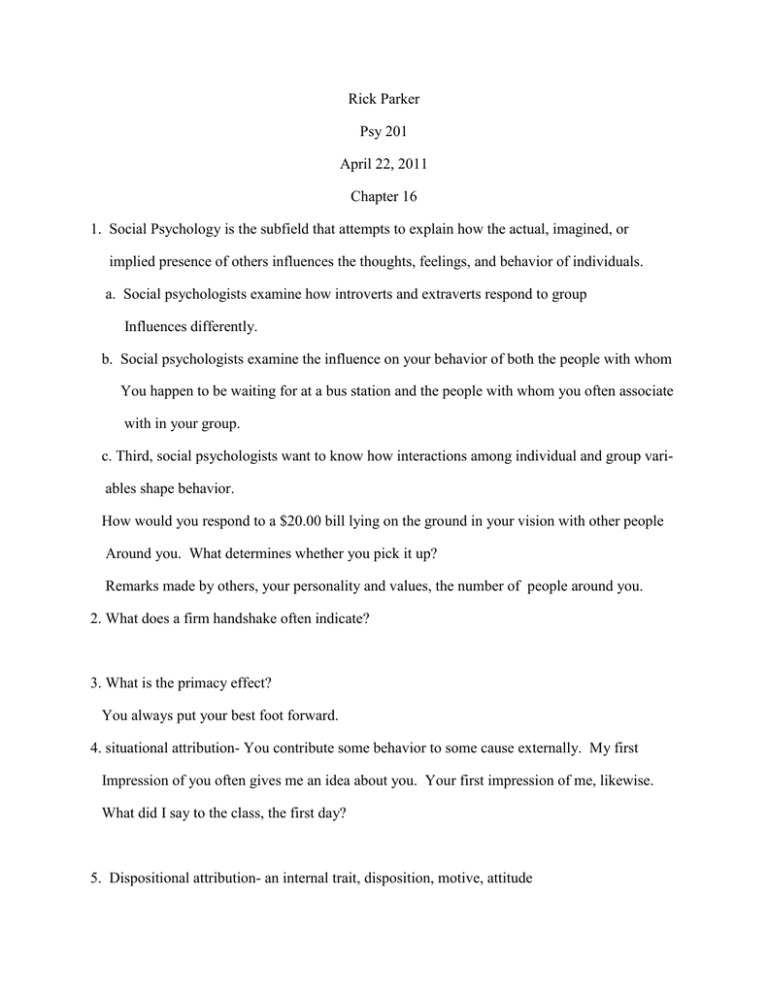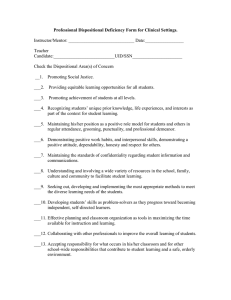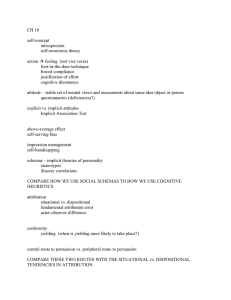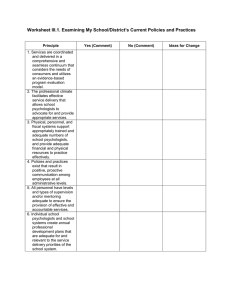Rick Parker Psy 201 April 22, 2011 Chapter 16
advertisement

Rick Parker Psy 201 April 22, 2011 Chapter 16 1. Social Psychology is the subfield that attempts to explain how the actual, imagined, or implied presence of others influences the thoughts, feelings, and behavior of individuals. a. Social psychologists examine how introverts and extraverts respond to group Influences differently. b. Social psychologists examine the influence on your behavior of both the people with whom You happen to be waiting for at a bus station and the people with whom you often associate with in your group. c. Third, social psychologists want to know how interactions among individual and group variables shape behavior. How would you respond to a $20.00 bill lying on the ground in your vision with other people Around you. What determines whether you pick it up? Remarks made by others, your personality and values, the number of people around you. 2. What does a firm handshake often indicate? 3. What is the primacy effect? You always put your best foot forward. 4. situational attribution- You contribute some behavior to some cause externally. My first Impression of you often gives me an idea about you. Your first impression of me, likewise. What did I say to the class, the first day? 5. Dispositional attribution- an internal trait, disposition, motive, attitude 6. The actor observer effect states that people tend to attribute their own shortcomings to external Factors and other peoples’ shortcomings to internal factors, dispositional attribution. For example, a basketball game was lost because my teammate did not catch the ball under the goal (situational attribute); what would be a dispositional attribute concerning the loss of the basketball game? 7. The fundamental attribution error- The tendency to attribute other peoples’ behaviors to dispositional factors. For example, seeing a coach scold a volleyball player for hitting a serve out of bounds may Cause one to state that the coach is mean, yet the situation might be that the player has poor Technique in learning how to serve, like myself. Managers who hire for jobs take into account dispositional attributions of employees that focus more on effort and not natural ability. 8. Factors influencing attractiona. proximity- closeness b. mere-exposure effect- feel more positive toward a stimulus as a result of repeated exposure to it. c. Our feelings-positive/negative d. Reciprocity- People who like us, we tend to like back. e. Similar interests/ leisure actitvities/ values f. Physical attractiveness g. People’s behavior- smiling h. symmetrical faces/bodies- this often indicates health of potential mates i. Halo effect- physical attraction often leads to other attractive qualities such as being exciting, personable, interesting, and socially desirable. 9. Matching Hypothesis- We tend to end up with partners who match us in physical attractiveness and other assets. 10. Men and women tend to select partners who are complimentary often. 11. Across cultures, men/women tend to choose mates who have mutual attraction/love, dependAble character, emotional stability and maturity, pleasing disposition 12. Conformity- Conform to social norms/obey; people tend to conform to social norms. 13. Group think- The tendency of members of a tightly knit group to be more concerned with Preserving group solidarity and uniformity than with objectively evaluating all alternatives. Managers need to hear all alternative plans before giving their opinions regarding decisions. 14. Compliance A. Foot in the door technique- Respond to a few questions/ followed by larger scale of questions B. Door in the face technique-Larger request followed by a smaller request C. Low Ball Technique- Agree to a survey, given at 7:00am in the morning 15. Social roles are socially defined behaviors that are considered appropriate for individuals Occupying certain positions within a given group. Deindividuation- Individuals lose their sense of identity when they are part of a group. Cheating when everyone else does. Social identity- The tendency to join others to construct a group identity that insulates individual members against a stressor. 16. Cognitive Dissonance- The unpleasant state that can occur when people become aware of in Consistencies between their attitudes and behaviors. 17. Celebrities who people trust often persuade along with personally relevant information used, the facts/emotions incorporated/ and repetition of info to an appropriate audience. 18. Aggression- Affected by low heart rate, genes, testosterone, and low levels of serotonin, brain tumors, neurological diseases, alcohol abuse, frustration, scapegoating, reduced personal space, crowding, learning 19. Prejudice- beliefs/emotions 20. Discrimination- Actions A. Causes 1. Competition 2. In group/Outgroup competition 3. Social cognitions/stereotypes B. Is prejudice decreasing?


